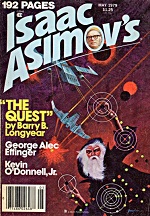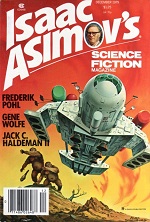|  
 
 | | | |  | | “The Dead of Winter”
by Kevin O'Donnell, Jr.
First publication: Asimov’s Science Fiction, May 1979

Four miners, trapped over winter in a mountain cabin, run out of food, but three people in a love triangle show up from the future with a couple of candy bars, a flask of drink, and a fued. “Oh, well—” He runs his pasty white hands through hispockets while Cole and the girl do the same. “I have a candy bar or two, I believe,” and he brings them out. “Cole, you have a bottle, don’t you?" “Oh, well—” He runs his pasty white hands through hispockets while Cole and the girl do the same. “I have a candy bar or two, I believe,” and he brings them out. “Cole, you have a bottle, don’t you?"
 The guy with the black hat scowls at him, but brings a flask out of his hip pocket and lays it on the table. The guy with the black hat scowls at him, but brings a flask out of his hip pocket and lays it on the table. 
| |
| | | | |

 
 
 
 
 
 | | | |  | | “Written in Sand”
by Robert Chilson
First publication: Asimov’s Science Fiction, Dec 1979

 Paul Enias travels from 21st century Egypt back to the third century where he becomes Pausanias, falls in love with the slave Taia, and takes advice from Appolonius about which of 750,000 available books to bury in clay jars for future Egyptians to discover. Paul Enias travels from 21st century Egypt back to the third century where he becomes Pausanias, falls in love with the slave Taia, and takes advice from Appolonius about which of 750,000 available books to bury in clay jars for future Egyptians to discover. Odd that the book-man should shrug off the value of books, but Pausanias had too much to do to ponder it, overseeing the copying, the shipping of the books up the Nile, the reorganization of his new estate, and of course there was taia, then a new—bride. Odd that the book-man should shrug off the value of books, but Pausanias had too much to do to ponder it, overseeing the copying, the shipping of the books up the Nile, the reorganization of his new estate, and of course there was taia, then a new—bride. 
| |
| | | | |

No Time Travel. Move along. |
“Back to Byzantium” by Mark J. McGarry, Asimov’s, Feb 1979 [ancestral memory ]

“Illusions” by Tony Sarowitz and Paul David Novitski, Asimov’s, Jun 1979 [just trust me:  ] ]

“The Thaw” by Tanith Lee, Asimov’s, Jun 1979 [long sleep ]

| |     |